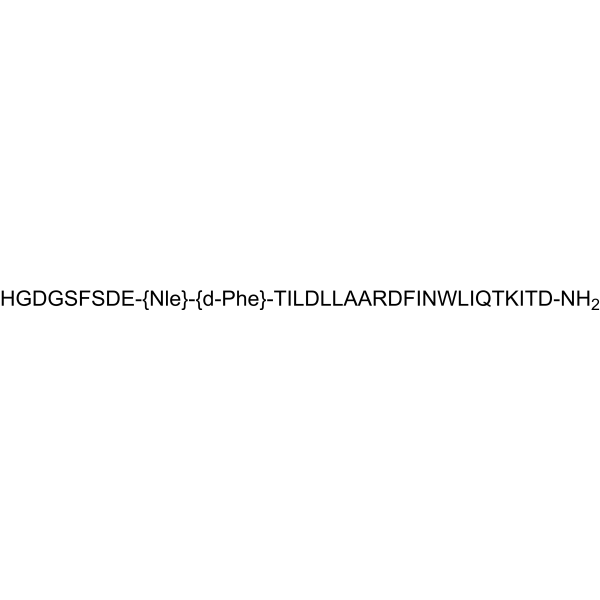
Sincalide ammonium
CAS No. 70706-98-8
Sincalide ammonium( Cholecystokinin octapeptide ammonium; CCK-8 ammonium; SQ19844 ammonium )
Catalog No. M29897 CAS No. 70706-98-8
Sincalide ammonium (Cholecystokinin octapeptide ammonium) is a rapid-acting amino acid polypeptide hormone analogue of cholecystokinin (CCK) for intravenous use in postevacuation cholecystography.
Purity : >98% (HPLC)
 COA
COA
 Datasheet
Datasheet
 HNMR
HNMR
 HPLC
HPLC
 MSDS
MSDS
 Handing Instructions
Handing Instructions
| Size | Price / USD | Stock | Quantity |
| 5MG | 222 | In Stock |


|
| 10MG | 357 | In Stock |


|
| 25MG | 587 | In Stock |


|
| 100MG | 1107 | In Stock |


|
| 200MG | Get Quote | In Stock |


|
| 500MG | 2214 | In Stock |


|
Biological Information
-
Product NameSincalide ammonium
-
NoteResearch use only, not for human use.
-
Brief DescriptionSincalide ammonium (Cholecystokinin octapeptide ammonium) is a rapid-acting amino acid polypeptide hormone analogue of cholecystokinin (CCK) for intravenous use in postevacuation cholecystography.
-
DescriptionSincalide ammonium (Cholecystokinin octapeptide ammonium) is a rapid-acting amino acid polypeptide hormone analogue of cholecystokinin (CCK) for intravenous use in postevacuation cholecystography.
-
In VitroSincalide ammonium (Cholecystokinin octapeptide ammonium, CCK-8 ammonium), as a novel cardiovascular hormone, has a significant inhibitory effect on myocardial fibrosis in noninfarcted areas. Sincalide ammonium also plays a positive role in fighting inflammation, apoptosis and collagen deposition. CCK‐8 (ammonium) protects H9c2 cardiomyoblasts from Ang II‐induced apoptosis partly via activation of the CCK1 receptor and the phosphatidyqinositol‐3 kinase/protein kinase B (PI3K/Akt) signaling pathway. Cell Viability Assaysup>Cell Line:H9c2 cells Concentration:0.001, 0.01, 0.1, 1, 10, or 100 μmol/L Incubation Time:24 h Result:Attenuated Ang II‐induced toxicity in H9c2 cells Apoptosis Analysis Cell Line:H9c2 cells Concentration:0.001, 0.01, 0.1, 1, 10, or 100 μmol/L Incubation Time:24 h Result:Decreased apoptotic cells, and prevented Ang II‐induced cytotoxicity that involves modulation of the PI3K/Akt pathway.Western Blot Analysis Cell Line:H9c2 cells Concentration:0.001, 0.01, 0.1, 1, 10, or 100 μmol/L Incubation Time:24 h Result:Expressed the protein and mRNAs of CCK and both its receptors in H9c2 cells.RT-PCR Cell Line:H9c2 cells Concentration:0.001, 0.01, 0.1, 1, 10, or 100 μmol/L Incubation Time:24 h Result:Increased the protein and mRNA expression levels of CCK and decreased CCK 1 receptor expression levels at both the protein and mRNA levels with Ang II stimulation markedly.
-
In VivoSincalide ammonium (Cholecystokinin octapeptide ammonium, CCK-8 ammonium) alleviates fibrosis in the noninfarcted regions and delay the left ventricular remodeling and the progress of heart failure in a MI rat model. Animal Model:MI rat modelDosage:50 μg/kg Administration:i.p.; 50 μg/kg/d; for 4 weeks Result:Had significant inhibitory effect on myocardial fibrosis in noninfarcted areas.
-
SynonymsCholecystokinin octapeptide ammonium; CCK-8 ammonium; SQ19844 ammonium
-
PathwayOthers
-
TargetOther Targets
-
Recptor——
-
Research Area——
-
Indication——
Chemical Information
-
CAS Number70706-98-8
-
Formula Weight1160.3
-
Molecular FormulaC49H65N11O16S3
-
Purity>98% (HPLC)
-
SolubilityH2O : 12.5 mg/mL (10.77 mM; Need ultrasonic)
-
SMILES——
-
Chemical NameSequence:Asp-{SO3H-Tyr}-Met-Gly-Trp-Met-Asp-Phe-NH2
Shipping & Storage Information
-
Storage(-20℃)
-
ShippingWith Ice Pack
-
Stability≥ 2 years
Reference
Maher KA. Kinevac (sincalide for injection)/Squibb Diagnostics. Gastroenterol Nurs. 1991 Oct;14(2):98-100.
molnova catalog



related products
-
N-desmethylmirtazapi...
N-desmethylmirtazapine is a metabolite of mirtazapine. N-desmethylmirtazapine is also commonly used as an anxiolytic, hypnotic, antiemetic, and appetite stimulant.
-
PHA-767491
PHA-767491 is a potent ATP-competitive dual Cdc7/CDK9 inhibitor with IC50 of 10 nM and 34 nM, respectively.
-
Oxyfluorfen
Oxyfluorfen, a herbicide of the nitrodiphenyl ether class, is used to control annual and perennial broad-leaved weeds and sedges in a variety of field crops.



 Cart
Cart
 sales@molnova.com
sales@molnova.com


